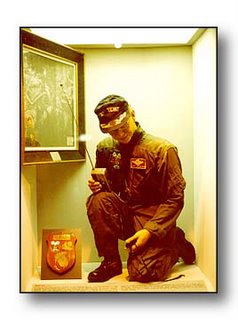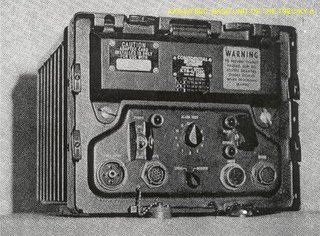This is coolbert: In my last blog entry, I made a reference to a link that described "Project Touchdown". My comments in bold on the article in the link:
"Thanks to our battalion S-2, 44th Signal Battalion soldiers were aware as early as 1965 that the enemy was probably monitoring USARV tactical-radio nets. The Army Security Agency tried to make everyone else a believer in this, too. However, as I mentioned in my article in the last Army Communicator [Books, Winter 2002 edition], despite ASA's many warnings, it was USARV's official opinion that the NVA/VC had no equipment capable of monitoring U.S. tactical-radio nets, nor could they understand English well enough to use the information if they had the equipment and, most importantly, our tactical forces moved so fast and our actions on the battlefield were so quick that even if the enemy managed to acquire some information from our tactical-radio nets, it would do them no good and us no harm. That arrogance was to cost us dearly."
The powers in charge were aware as early as 1965 that something was going on. MANY WARNINGS, MANY WARNINGS!!! Not sure what, but aware something was happening.
"Since there was no COMSEC device, either internal or external, provided to this equipment until late in the conflict, the only solution was to constantly stress the vulnerability of FM voice radio to intercept and analysis and to carefully use Signal operating instructions, off-line (paper) operations codes and authentication tables (challenge and reply) to provide net security. As I said, however, before late 1969, the USARV and Military Assistance Command Vietnam commanders steadfastly refused to believe there was a real COMINT threat. This attitude was reflected across the entire force at every level."
There was comsec equipment available. But a lot of it was bulky and potentially difficult to use. Paper codes and challenge/reply, if well designed and used judiciously, are effective.
"Accordingly, since existing operations codes and authentication tables were cumbersome for the typical poorly trained FM voice radio operators (most of who were officers and senior noncommissioned officers) to use, they were rarely employed."
This stuff was available, but the operators were poorly trained. And a lot of them just did not take the time to do things right. It was the Army's doctrine at the time not to have dedicated trained radio operators at the maneuver level for the most part. Any soldier was supposed to be capable of handling the radio.
"our astute enemy used to extreme advantage."
Astute is an understated characterization if anything.
"No one to my knowledge has ever been able to calculate the number of names on the Vietnam Wall due to poor COMSEC, but all indications are that the number is considerable. The number of Americans killed and wounded in action due to lack of radio security certainly must, in my opinion, far exceed the much-publicized losses due to friendly fire or non-combat related deaths due to accidents, for example."
This is probably a fair estimate.
Embarrassed by Alpha-3
"Fortunately, in late December 1969--almost four years after the U.S. Army deployed major units to Vietnam and after four years of exposing our combat-radio nets to exploitation--the situation changed dramatically. On the morning of Dec. 20, 1969, a scout from 1st Brigade, 1st Infantry Division, discovered a long wire antenna on the ground at the old Michelin rubber plantation in the area northwest of Saigon. The antenna wire led to a carefully concealed underground bunker complex that was packed with enemy radio-communications intercept equipment. This complex was the operations center for an NVA/VC platoon-sized radio "technical reconnaissance unit" known as Alpha-3 that was part of the NVA's 47th Technical Reconnaissance Battalion."
And this was almost five years, maybe it was five years, after the U.S. had become committed big time to ground action in Vietnam. All this time disaster was taking place, unknown to the U.S. forces. And the only reason this unit was found was by the U.S. patrol having a "Kit Carson" scout [VC defector who agreed to work for U.S. forces] finding the long-wire antenna of the enemy unit and following it to the dug out. Without him finding the antenna, this unit may have not been discovered!!??
"After a short fight, 12 members of Alpha-3 were taken prisoner. Even more significant, however, was the fact that U.S. infantry also captured all of Alpha-3's equipment and its logbooks. These logbooks proved without doubt that the enemy had been intercepting U.S. voice radio traffic over an extended period of time, understood the exact meaning of the traffic and were able to easily decrypt and understand traffic covered by unauthorized (locally made) codes and infrequent SOI changes."
One enemy interceptor was killed and twelve captured. It is very important that the prisoners were taken with their gear and logs captured intact too. This is useful in interrogations.
"Alpha-3's stuff consisted mostly of captured AN/PRC-25 or AN/PRC-77 radios and others bought from our South Vietnam allies or through third parties. Obviously, this equipment was 100 percent interoperable with the radios in our units since it was identical to our equipment. Supplementing the captured or acquired U.S. standard very-high-frequency equipment, Alpha-3 had several Chinese R-139 HF receivers and a good number of Sony and Panasonic commercial radios they had simply modified to work in the U.S. tactical-frequency bands."
Some of those commercial radios were stolen by GI's after the fact!!??
"Alpha-3 soldiers discovered they could solder together eight BA-30 D-cell flashlight batteries (no shortage of these) and produce the 12 volts of direct-current power the AN/PRC-25 needed to receive signals."
The transmit side of the radio was disabled and only the receive portion used. It would work on 12 Vdc.
"Alpha-3 was able to produce antennas that extended the normal operating distances of their radio-intercept receivers far beyond their expected range."
That long wire antenna was used extensively. Somehow it was resting only one foot above the ground and was able to pick up transmissions of all sorts. Not the sort of thing any respectable engineer would design. But it was not only effective as a radio antenna, it was camouflaged too. It was only the Kit Carson scout that knew what to look for that spotted it!!??
"Supposedly ignorant Third World Alpha-3 soldiers were expert enough to actually build radio receivers in the field from new and used parts obtained or manufactured locally."
Well, these guys must have had a lot of experience. Years worth. Maybe decades worth. Worked against the French and the South Vietnamese too??
"In short, Alpha-3 was reading our mail and knew exactly what it meant and what to do about it. U.S. infantrymen found handwritten logs containing the texts of American voice conversations transcribed verbatim in English and then analyzed by excellent English linguists."
These English linguists were described as having a PROFOUND knowledge of English. To develop that ability, it is normal practice to have lived among the native speakers. What is that??!!
"The civilian press, in fact, proved to be a great source of immediate operational information throughout the war. Present-day commanders should take a lesson from this when considering allowing the civilian press and its normally uncovered communications (satellite phone, cellphone, etc.) into their operations area."
Damned press as usual. If you told them this, they would have scoffed and talked about 1st Amendment rights or something. And how many of them were foreign reporters maybe in cahoots with the enemy and sending that stuff knowing it would be picked up???!!!
"The Alpha-3 logs showed us that back in 1965 we were passing this operations-security information over the air in the clear because we underestimated the enemy's COMINT capabilities:"
Again, at least since 1965. That is five years and nothing was known??
"U.S. units made extensive use of locally produced unauthorized codes"
Even if an unauthorized code works and is 100 % secure, you don't want to use it. Makes your unit stand out.
"* U.S. units often failed to use authentication procedures in a deception environment. This was particularly evident under a higher-stress situation such as medical evacuation, search-and-rescue, quick-fire artillery targets and units in contact with the enemy. The NVA's imitative communications deception could exploit this U.S. characteristic to lure evacuation and SAR aircraft into preplanned "kill boxes," misdirect artillery fire to harmless locations or on to U.S. forces and disrupt, confuse and expose maneuvering U.S. troops. I personally saw this at work in 1969, when an unauthenticated transmission caused 69th Signal Battalion's base camp at Ben Hua to be shelled, producing produced several casualties."
This is shown somewhat in the movie "BAT-21". Each and every pilot carried a vest on his body with a small beacon radio. Rescue aircraft could "home" on that beacon to rescue the downed pilot. The enemy would take these radios, set up an ambush, and activate the radio, hoping to catch U.S. chopper rescuers in a RPG ambush. I have informants that tell me they have talked to chopper pilots about this and not one has ever said they knew a thing about any of this!!??

"* U.S. radio operators, many of who were field-grade commissioned officers and senior noncommissioned officers, lacked proper circuit discipline."
If a lowly private made a security violation, I bet he would have never heard the end of it. Let a senior officer or NCO do the same thing or worse, and it would be command responsibility and decision.
"* Secure communications equipment, if available, was almost never used between 1965 and 1969, since the equipment (Nestor) was bulky"
Well, this stuff was available. And it was bulky. And prone to overheating too.

"After this, Abrams' hostility to Signal Corps officers, our training, doctrine and tactics as taught and conceived at Fort Gordon--and particularly Signal officers in S-6/G-6 assignments battalion through corps--is legendary. Led by the MACV high command, the Signal Corps quickly became the target for an unmerciful attack by our combat-arms brethren, who at the time needed a blood sacrifice and something to blame for why the ground war was not going particularly well. Unfortunately, much of the attack was well deserved."
To begin with, despite WARNINGS, the top brass ignored the advice that their message traffic was subject to intercept and exploitation. This is a fact. So they need to blame someone else. Someone else was negligent too, this is also a fact. Signal did not do it's job. But leadership must flow from the top downward.
"Many today will say of what relevance is this almost 40-year-old information to today's Army and Signal Corps?"
This stuff is as relevant to day as it was forty years ago. Will always be relevant.
" Never underestimate the capabilities of your "electronic enemy."
The devices and proper net-operations procedures do no good if you don't use them."
Well, it is all true. And how well are the procedures and devices being used now. I bet I know, but I am afraid to say. I hope for the best, but fear the worst. Maybe I am just a pessimist at heart.
coolbert.

0 Comments:
Post a Comment
Subscribe to Post Comments [Atom]
<< Home